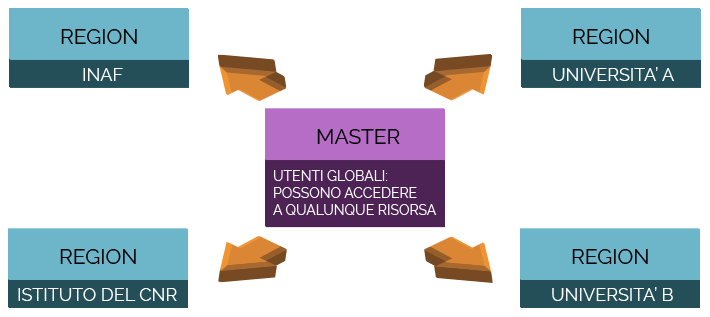Features
GARR uses OpenStack, an open source solution that has become a de facto standard, supported by tens of thousands companies and developers worldwide.
To deploy and manage a cloud computing platform characterized by high levels of complexity, GARR chose to adopt the declarative model, which allows users to describe the structure and dependencies between various parts of the platform. A specific automation tool analyses the model and produces a plan of specific operations to deploy or update the installation, thus limiting the need for manual interventions by administrators.
The service deployment mechanism is the same for all levels, and can be used to install the platform itself, a cloud region, a single application or a complex combination of services, e.g. a Hadoop cluster for Big Data analysis. The installation can be performed in a cluster of physical or virtual machines, on any region of the federated cloud and even on a public cloud. This makes the services easily portable from a cloud to another and platform-independent.
The GARR Cloud Platform has a federated architecture, which allows for the integration of resources from private clouds in the GARR community as well as public clouds. Members of the GARR community who are part of the federation can create their own cloud region, sharing resources and services while maintaining control over them through a mechanism of administrative proxy.
The declarative deployment model facilitates the creation of federated regions, which can be created automatically in just a few hours.
Currently the platform includes a master region, split in three areas hosted in the GARR-X Progress data centres and capable of integrating with the major public clouds.
Federated architecture
The GARR cloud platform is based on a federated architecture, which allows organizations from the GARR community to share their resources over the cloud, while maintaining administrative control over them.
This approach extends to cloud computing the same successful community based model used for networking, seen as a Commons: in this case, the goal is to make the community an actor of the transition to cloud computing rather than resorting just to public/commercial clouds.
The federated model allows a widespread participation to the cloud project, facilitates the exchange of competencies and allows the infrastructure to grow organically as new resources are made available.
Each member can make available a certain amount of resources, building a cloud region. Resources in different regions are jointly managed through automated tools that reduce the workload related to the cloud management. The effort needed to manage a complex cloud platform can thus be shared among different groups.

Public clouds can also be integrated in the Federated cloud, thus creating hybrid ones that can offer extra flexibility to absorb extraordinary peaks in computing demand.
The GARR Cloud Platform users are recognised within the whole federation, which facilitates cross-organizations collaborations. They can transparently access the shared resources with their usual Idem or Open Id Connect (Google) identities or, lacking them, through credentials issued during the registration.
Technologies
GARR chose to use open source software for its cloud, thus avoiding the risk of vendor lock-in. The choice fell on the OpenStack framework and on MaaS and Juju automation tools by Canonical, also known for the Ubuntu Linux distribution.
OpenStack is currently one of the most widely adopted and supported cloud computing platforms, supported by a community of over 45.000 developers worldwide. The use of automation and orchestration tools allows for automatic cloud installation and maintenance processes. Thus, GARR has achieved levels of efficiency more commonly seen in the large data centres of Google and AWS, while maintaining an agile organisation and a relatively small technical team.

 Telegram
Telegram